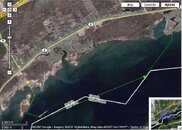fisherdvm
Contributor
- Messages
- 3,577
- Reaction score
- 52
- # of dives
- 200 - 499
This author made a waterproof housing for his gps with switches on the outside. He floats it up to the surface for a gps reading, and retrieve it underwater to navigate, or assist in his navigation. Interesting read.
Here is a link for the following free book on this topic:
Underwater GPS - Captain's Blog SCUBA Blog - Dive Spots
The link below will allow you to download my book / manual-
"Underwater GPS: a practical approach"
The book is free and is not a promotion for the sale of
any product. I'm distributing this pdf document, in hopes of encouraging the use of Diver GPS by avid divers, researchers, law enforcement dive teams, and public safety divers. I would certainly like to hear feedback or questions from users.
http://wl.filegenie.com/~8675309/UW_GPS_Book.pdf
Here is a link for the following free book on this topic:
Underwater GPS - Captain's Blog SCUBA Blog - Dive Spots
The link below will allow you to download my book / manual-
"Underwater GPS: a practical approach"
The book is free and is not a promotion for the sale of
any product. I'm distributing this pdf document, in hopes of encouraging the use of Diver GPS by avid divers, researchers, law enforcement dive teams, and public safety divers. I would certainly like to hear feedback or questions from users.
http://wl.filegenie.com/~8675309/UW_GPS_Book.pdf





